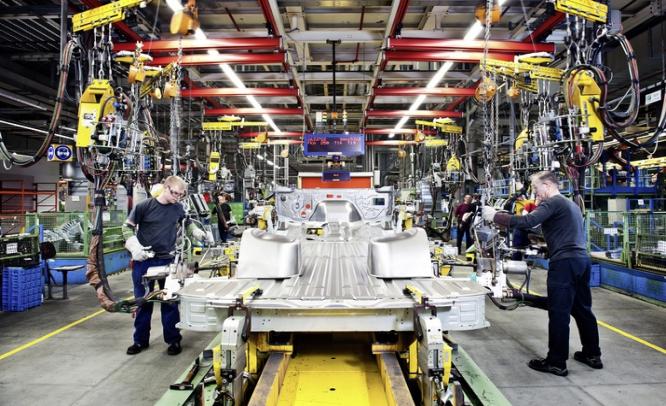Manufacturing growth registered for 10 months in a row despite subdued increase in new orders, reports Team IFM
Berlin, May 7: Germany’s manufacturing sector brushed aside weaker increase in new orders to swagger into the second quarter, having notched growth figures for the 10th consecutive month in April, according to independent data released late last week.
Operating conditions at the country’s factories improved at a slightly sharper rate last month, with the final seasonally adjusted Markit-BME Germany Manufacturing Purchasing Managers’ Index or PMI – a single-figure snapshot of the performance of the manufacturing economy – rising from 53.7 in March to 54.1.
The latest reading stretched the current sequence of growth to 10 months, said economy tracker Markit which prepared he survey report on behalf of BME, a German association of materials management companies.
Survey participants attributed the rise to improving economic conditions and increased order intakes. Manufacturers of intermediate goods benefited the most. Alongside, new export orders saw an upturn for the ninth straight month, leading to reduction in old backlog, but creating new ones.
“Following the trend observed since May last year, output rose during April, and the pace of expansion was the second-quickest in nearly three years,” Markit said in its report. “Sector data suggested that the sharpest rise in production was reported by intermediate goods companies, followed by investment goods producers.”
The manufacturing sector’s robust show was in sharp contrast to that of the German retail segment, which saw its March sales figures dented as compared to the year-ago period, primarily because Easter shopping shifted to April this year.
Interestingly, retail sales fell despite employment having risen in the month under review, with 376,000 more people being recruited in March this year, reflecting an increase of 0.9 over that of March 2013.
There was no such concern for manufacturers though. “Final PMI data signalled a slight acceleration in Germany’s manufacturing upturn in April, with production growth the second-sharpest in nearly three years,” said Oliver Kolodseike, economist at Markit and author of the report.
AREAS OF CONCERN
New orders at the factories rose in April, but the rate of growth eased to a five-month low. “Nevertheless, the increase was sharp, with more than one-in-three panellists reporting fuller order books,” Markit said. “Meanwhile, new export work also increased at a slower pace, with the latest rise the slowest since October last year.”
With output and new orders rising, German manufacturers hired additional workers in April. Panel respondents commented that higher production requirements and expected growth in the coming months were some of the main reasons behind the increase in employment.
Meanwhile, capacity pressures continued to build, with backlogs rising further.
German goods producers reported a further increase in buying activity in April. The rate of growth eased, however, to the weakest in six months.
Some companies lowered their purchasing activity in an attempt to deliberately reduce inventories, while higher production requirements accounted for much of the overall rise, Markit said.
April data pointed to a reduction in both stocks of purchases and stocks of finished goods, with the rates of decline the sharpest in four and 13 months, respectively.
On the price front, input costs fell to the largest extent in nine months, with companies commenting on successful price negotiations, increased competition among suppliers and lower prices for some raw materials. Concurrently, output charges were flat, following a slight reduction in March.
Finally, suppliers’ delivery times deteriorated for the ninth month running in April, with companies commenting on increased workloads. “Despite robust output growth, companies were relatively cautious with regard to hiring efforts and buying activity,” said Markit’s Kolodseike.
“New export business growth eased to a six-month low and input costs fell at the sharpest rate since July last year. The following months will show whether April’s weak export reading was only a temporary blip or if the appreciation of the euro is having a noticeable effect on client demand from export markets.”
The report is produced by Markit Economics and is based on original survey data collected from a representative panel of over 500 companies based in the German manufacturing sector.
The final Germany Manufacturing PMI follows on from the flash estimate which is released a week earlier and is typically based on at least 75 percent of total PMI survey responses each month. The April flash was based on 91 percent of the replies used in the final data.
PAYROLL PUSH
The data threw new light on the job front, with Markit saying though employment continued to rise, it was “at a very moderate pace”. Payroll numbers are reflective of demand for goods, which in turn can be a gauge for the manufacturing sector.
It also noted that firms raised their purchasing activity to the weakest extent in six months, in part reflecting a slower expansion in new orders.
However, the Statistical Office said a few days earlier that the job situation in Germany was much better in March 2014 compared to a year-ago period. According to it, roughly 2.3 million people were unemployed in the month under review – 53,000 less than a year earlier.
The statistical office Destatis said that in March this year, roughly 41.8 million German residents were employed, an increase of 376,000, or 0.9 percent over that of March 2013.
Compared with the previous corresponding period, it said, job creation witnessed “a slight increase in the growth rate” in the December 2013-February 2014 period.
According to provisional results of the employment accounts, the number of persons in employment increased by 99,000, or 0.2 percent, from February to March. This was “because of the start of the spring upturn,” Destatis said in its statement.
“After seasonal adjustment, that is, after the elimination of the usual seasonal fluctuations, the number of persons in employment increased by 37,000, or 0.1 percent, in March 2014 compared with the previous month,” it added.


